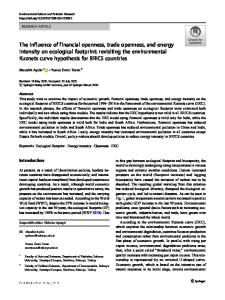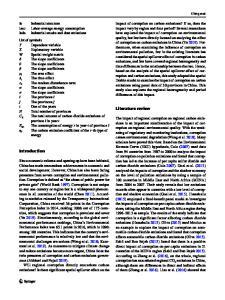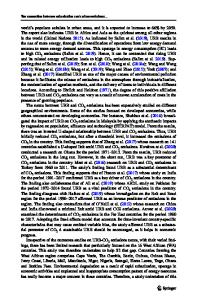The effect of trade openness on the relationship between agricultural technology inputs and carbon emissions: evidence f
- PDF / 2,349,237 Bytes
- 14 Pages / 595.276 x 790.866 pts Page_size
- 52 Downloads / 244 Views
RESEARCH ARTICLE
The effect of trade openness on the relationship between agricultural technology inputs and carbon emissions: evidence from a panel threshold model Xiaocang Xu 1,2 & Na Zhang 1 & Dongxue Zhao 3
&
Chengjie Liu 1
Received: 21 September 2020 / Accepted: 13 October 2020 # Springer-Verlag GmbH Germany, part of Springer Nature 2020
Abstract The development of low-carbon agriculture systems has been a global consensus to reduce carbon emissions in the agricultural sector for addressing climate change challenges. This fact brings the need to study the agricultural carbon emissions (ACEs). Studies focusing on calculating the spatiotemporal changes of ACEs and analyzing the main factors for ACE changes have been conducted. The agricultural technology inputs (ATIs) as an important factor to influence ACEs have been identified. The traditional linear model was the commonly used method to study the relationship between ATIs and ACEs, whereas the impact of ATIs on ACEs in different areas might be complex and nonlinear due to the differences in trade openness causing different development levels of agricultural technologies. Therefore, this study aims to investigate the effect of trade openness on the relationship between ATIs and ACEs using a panel threshold model and put forward policy implications for the low-carbon agriculture development. The analysis was based on data from a panel of 31 provinces of China during 2003–2018. The results show that ATIs and ACEs increased from 2003 to 2018 and the spatial distribution of ATIs was similar to that of ACEs. The ATIs had a positive effect on ACEs with a significant single-threshold effect from trade openness. When the trade openness was below the threshold (0.1425), the positive effect of ATIs on ACEs was significant (coefficient, 0.117), whereas, when the trade openness was above the threshold (0.1425), the positive effect of ATIs on ACEs significantly decreased (coefficient, 0.062). Furthermore, industrial structure and agricultural economic development were the positive drivers of ACEs, while trade openness, education level of rural workers, R&D funding, and natural disasters had negative relationships with ACEs. The results provide valuable references for understanding ACE drivers and developing low-carbon agriculture with the consideration of ATIs and trade openness. Keywords Agricultural carbon emissions (ACEs) . Trade openness . Agricultural technology inputs (ATIs) . Panel threshold model . Threshold effect
Introduction The increasing of carbon emissions in the atmosphere has caused adverse effects on the climate, environment, Responsible editor: Nicholas Apergis * Dongxue Zhao [email protected]; [email protected] 1
School of Economics, Chongqing Technology and Business University, Chongqing 400067, China
2
Department of Actuarial Studies & Business Analytics, Macquarie University, Sydney, NSW 2109, Australia
3
School of Biological, Earth and Environmental Science, UNSW Sydney, Kensington, NSW 2052, Australia
ecosystem, and human well-be
Data Loading...











